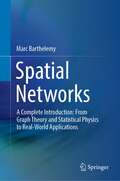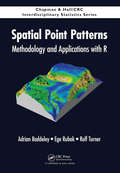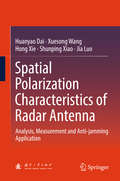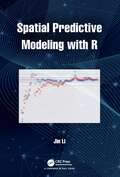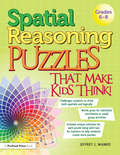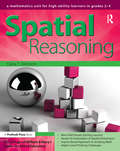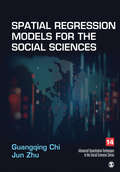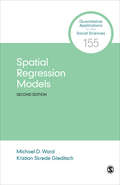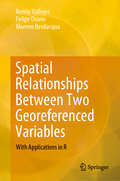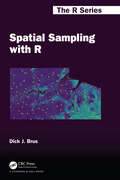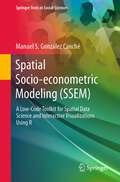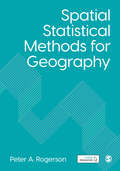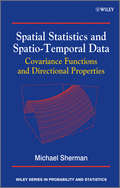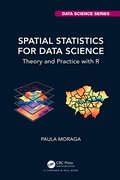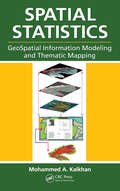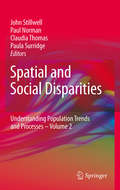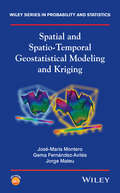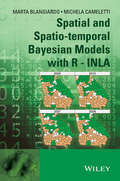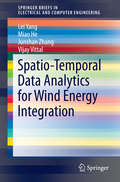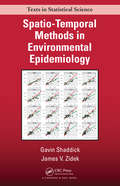- Table View
- List View
Spatial Networks: A Complete Introduction: From Graph Theory and Statistical Physics to Real-World Applications (Lecture Notes In Morphogenesis Ser.)
by Marc BarthelemyThis book provides a complete introduction into spatial networks. It offers the mathematical tools needed to characterize these structures and how they evolve in time and presents the most important models of spatial networks.The book puts a special emphasis on analyzing complex systems which are organized under the form of networks where nodes and edges are embedded in space. In these networks, space is relevant, and topology alone does not contain all the information. Characterizing and understanding the structure and the evolution of spatial networks is thus crucial for many different fields, ranging from urbanism to epidemiology.This subject is therefore at the crossroad of many fields and is of potential interest to a broad audience comprising physicists, mathematicians, engineers, geographers or urbanists. In this book, the author has expanded his previous book ("Morphogenesis of Spatial Networks") to serve as a textbook and reference on this topic for a wide range of students and professional researchers.
Spatial Point Patterns: Methodology and Applications with R (Chapman & Hall/CRC Interdisciplinary Statistics)
by Adrian Baddeley Ege Rubak Rolf TurnerModern Statistical Methodology and Software for Analyzing Spatial Point PatternsSpatial Point Patterns: Methodology and Applications with R shows scientific researchers and applied statisticians from a wide range of fields how to analyze their spatial point pattern data. Making the techniques accessible to non-mathematicians, the authors draw on th
Spatial Polarization Characteristics of Radar Antenna: Analysis, Measurement and Anti-jamming Application
by Hong Xie Jia Luo Huanyao Dai Xuesong Wang Shunping XiaoThis book presents novel research ideas and offers insights into radar system design, artificial intelligence and signal processing applications. Further, it proposes a new concept of antenna spatial polarization characteristics (SPC), suggesting that the antenna polarization is a function of the spatial direction and providing new ideas for radar signal processing (RSP) and anti-jamming. It also discusses the design of an advanced signal-processing algorithm, and proposes new polarimetric and anti-jamming methods using antenna inherent properties. The book helps readers discover the potential of radar information processing and improve its anti-interference and target identification ability. It is of interest to university researchers, radar engineers and graduate students in computer science and electronics who wish to learn the core principles, methods, algorithms, and applications of RSP.
Spatial Predictive Modelling with R
by Jin LiSpatial predictive modeling (SPM) is an emerging discipline in applied sciences, playing a key role in the generation of spatial predictions in various disciplines. SPM refers to preparing relevant data, developing optimal predictive models based on point data, and then generating spatial predictions. This book aims to systematically introduce the entire process of SPM as a discipline. The process contains data acquisition, spatial predictive methods and variable selection, parameter optimization, accuracy assessment, and the generation and visualization of spatial predictions, where spatial predictive methods are from geostatistics, modern statistics, and machine learning. The key features of this book are: •Systematically introducing major components of SPM process.•Novel hybrid methods (228 hybrids plus numerous variants) of modern statistical methods or machine learning methods with mathematical and/or univariate geostatistical methods.•Novel predictive accuracy-based variable selection techniques for spatial predictive methods.•Predictive accuracy-based parameter/model optimization.•Reproducible examples for SPM of various data types in R. This book provides guidelines, recommendations, and reproducible examples for developing optimal predictive models by considering various components and associated factors for quality-improved spatial predictions. It provides valuable tools for researchers, modelers, and university students not only in SPM field but also in other predictive modeling fields. Dr Li has produced over 100 various publications in spatial predictive modelling, statistical computing, ecological and environmental modelling, and ecology, developed a number of hybrid methods for SPM, and published four R packages for variable selections as well as SPM.
Spatial Reasoning Puzzles That Make Kids Think!: Grades 6-8
by Jeffrey J. WankoSpatial Reasoning Puzzles That Make Kids Think! engages even the most reluctant math learner. In this fun and challenging book, students must conquer four types of logical and spatial reasoning puzzles (Slitherlink, Hashiwokakero, Masyu, and Yajilin). The rules for each type of puzzle are very different, but easy to understand. The challenge is for students to apply their critical thinking skills to new situations and develop new strategies for solving each puzzle. Teacher support is provided for solving the puzzles and also for helping students to create puzzles of their own. Students will be begging for more of these unique spatial reasoning puzzles!Grades 6-8
Spatial Reasoning: A Mathematics Unit for High-Ability Learners in Grades 2-4
by Dana T. JohnsonSpark the visual learning of students in grades 2-4 with Spatial Reasoning, a mathematics unit for high-ability learners. Gifted students demonstrate an advanced aptitude for spatial reasoning at early ages, and they require more complex lessons than what the standard curriculum provides. This field-tested unit approaches spatial reasoning through one-dimensional (1-D), two-dimensional (2-D), and three-dimensional (3-D) tasks that will engage students.The lessons in this unit are differentiated for gifted learners, and they are supported by hands-on extension activities that extend spatial concepts beyond the classroom. The skills learned throughout this unit will lay the foundation of spatial reasoning that will prepare students for middle school and beyond.Spatial Reasoning was developed by the Center for Gifted Education at The College of William and Mary.Grades 2-4
Spatial Regression Models for the Social Sciences (Advanced Quantitative Techniques in the Social Sciences #14)
by Jun Zhu Guangqing ChiSpatial Regression Models for the Social Sciences shows researchers and students how to work with spatial data without the need for advanced mathematical statistics. Focusing on the methods that are commonly used by social scientists, Guangqing Chi and Jun Zhu explain what each method is and when and how to apply it by connecting it to social science research topics. Throughout the book they use the same social science example to demonstrate applications of each method and what the results can tell us.
Spatial Regression Models for the Social Sciences (Advanced Quantitative Techniques in the Social Sciences #14)
by Jun Zhu Guangqing ChiSpatial Regression Models for the Social Sciences shows researchers and students how to work with spatial data without the need for advanced mathematical statistics. Focusing on the methods that are commonly used by social scientists, Guangqing Chi and Jun Zhu explain what each method is and when and how to apply it by connecting it to social science research topics. Throughout the book they use the same social science example to demonstrate applications of each method and what the results can tell us.
Spatial Regression Models: Spatial Regression Models (Quantitative Applications in the Social Sciences #155)
by Kristian Skrede Gleditsch Michael D. WardSpatial Regression Models illustrates the use of spatial analysis in the social sciences within a regression framework and is accessible to readers with no prior background in spatial analysis. The text covers different modeling-related topics for continuous dependent variables, including mapping data on spatial units, creating data from maps, analyzing exploratory spatial data, working with regression models that have spatially dependent regressors, and estimating regression models with spatially correlated error structures. Using social science examples based on real data, the authors illustrate the concepts discussed, and show how to obtain and interpret relevant results. The examples are presented along with the relevant code to replicate all the analysis using the R package for statistical computing. Users can download both the data and computer code to work through all the examples found in the text. New to the Second Edition is a chapter on mapping as data exploration and its role in the research process, updates to all chapters based on substantive and methodological work, as well as software updates, and information on estimation of time-series, cross-sectional spatial models.
Spatial Regression Models: Spatial Regression Models (Quantitative Applications in the Social Sciences #155)
by Kristian Skrede Gleditsch Michael D. WardSpatial Regression Models illustrates the use of spatial analysis in the social sciences within a regression framework and is accessible to readers with no prior background in spatial analysis. The text covers different modeling-related topics for continuous dependent variables, including mapping data on spatial units, creating data from maps, analyzing exploratory spatial data, working with regression models that have spatially dependent regressors, and estimating regression models with spatially correlated error structures. Using social science examples based on real data, the authors illustrate the concepts discussed, and show how to obtain and interpret relevant results. The examples are presented along with the relevant code to replicate all the analysis using the R package for statistical computing. Users can download both the data and computer code to work through all the examples found in the text. New to the Second Edition is a chapter on mapping as data exploration and its role in the research process, updates to all chapters based on substantive and methodological work, as well as software updates, and information on estimation of time-series, cross-sectional spatial models.
Spatial Relationships Between Two Georeferenced Variables: With Applications in R
by Ronny Vallejos Felipe Osorio Moreno BevilacquaThis book offers essential, systematic information on the assessment of the spatial association between two processes from a statistical standpoint. Divided into eight chapters, the book begins with preliminary concepts, mainly concerning spatial statistics. The following seven chapters focus on the methodologies needed to assess the correlation between two or more processes; from theory introduced 35 years ago, to techniques that have only recently been published. Furthermore, each chapter contains a section on R computations to explore how the methodology works with real data. References and a list of exercises are included at the end of each chapter. The assessment of the correlation between two spatial processes has been tackled from several different perspectives in a variety of applications fields. In particular, the problem of testing for the existence of spatial association between two georeferenced variables is relevant for posterior modeling and inference. One evident application in this context is the quantification of the spatial correlation between two images (processes defined on a rectangular grid in a two-dimensional space). From a statistical perspective, this problem can be handled via hypothesis testing, or by using extensions of the correlation coefficient. In an image-processing framework, these extensions can also be used to define similarity indices between images.
Spatial Sampling with R (Chapman & Hall/CRC The R Series)
by Dick J. BrusScientific research often starts with data collection. However, many researchers pay insufficient attention to this first step in their research. The author, researcher at Wageningen University and Research, often had to conclude that the data collected by fellow researchers were suboptimal, or in some cases even unsuitable for their aim. One reason is that sampling is frequently overlooked in statistics courses. Another reason is the lack of practical textbooks on sampling. Numerous books have been published on the statistical analysis and modelling of data using R, but to date no book has been published in this series on how these data can best be collected. This book fills this gap. Spatial Sampling with R presents an overview of sampling designs for spatial sample survey and monitoring. It shows how to implement the sampling designs and how to estimate (sub)population- and space-time parameters in R. Key features Describes classical, basic sampling designs for spatial survey, as well as recently developed, advanced sampling designs and estimators Presents probability sampling designs for estimating parameters for a (sub)population, as well as non-probability sampling designs for mapping Gives comprehensive overview of model-assisted estimators Covers Bayesian approach to sampling design Illustrates sampling designs with surveys of soil organic carbon, above-ground biomass, air temperature, opium poppy Explains integration of wall-to-wall data sets (e.g. remote sensing images) and sample data Data and R code available on github Exercises added making the book suitable as a textbook for students The target group of this book are researchers and practitioners of sample surveys, as well as students in environmental, ecological, agricultural science or any other science in which knowledge about a population of interest is collected through spatial sampling. This book helps to implement proper sampling designs, tailored to their problems at hand, so that valuable data are collected that can be used to answer the research questions.
Spatial Socio-econometric Modeling: A Low-Code Toolkit for Spatial Data Science and Interactive Visualizations Using R (Springer Texts in Social Sciences)
by Manuel S. González CanchéWith the primary goal of expanding access to spatial data science tools, this book offers dozens of minimal or low-code functions and tutorials designed to ease the implementation of fully reproducible Spatial Socio-Econometric Modeling (SSEM) analyses. Designed as a University of Pennsylvania Ph.D. level course for sociologists, political scientists, urban planners, criminologists, and data scientists, this textbook equips social scientists with all concepts, explanations, and functions required to strengthen their data storytelling. It specifically provides social scientists with a comprehensive set of open-access minimal code tools to:•Identify and access place-based longitudinal and cross-sectional data sources and formats•Conduct advanced data management, including crosswalks, joining, and matching•Fully connect social network analyses with geospatial statistics•Formulate research questions designed to account for place-based factors in model specification and assess their relevance compared to individual- or unit-level indicators•Estimate distance measures across units that follow road network paths •Create sophisticated and interactive HTML data visualizations cross-sectionally or longitudinally, to strengthen research storytelling capabilities•Follow best practices for presenting spatial analyses, findings, and implications•Master theories on neighborhood effects, equality of opportunity, and geography of (dis)advantage that undergird SSEM applications and methods•Assess multicollinearity issues via machine learning that may affect coefficients' estimates and guide the identification of relevant predictors•Strategize how to address feedback loops by using SSEM as an identification framework that can be merged with standard quasi-experimental techniques like propensity score models, instrumental variables, and difference in differences•Expand the SSEM analyses to connections that emerge via social interactions, such as co-authorship and advice networks, or any form of relational dataThe applied nature of the book along with the cost-free, multi-operative R software makes the usability and applicability of this textbook worldwide.
Spatial Statistical Methods for Geography
by Peter A. RogersonThis accessible new textbook offers a straightforward introduction to doing spatial statistics. Grounded in real world examples, it shows you how to extend traditional statistical methods for use with spatial data. The book assumes basic mathematical and statistics knowledge but also provides a handy refresher guide, so that you can develop your understanding and progress confidently. It also: · Equips you with the tools to both interpret and apply spatial statistical methods · Engages with the unique considerations that apply when working with geographic data · Helps you build your knowledge of key spatial statistical techniques, such as methods of geographic cluster detection.
Spatial Statistical Methods for Geography
by Peter A. RogersonThis accessible new textbook offers a straightforward introduction to doing spatial statistics. Grounded in real world examples, it shows you how to extend traditional statistical methods for use with spatial data. The book assumes basic mathematical and statistics knowledge but also provides a handy refresher guide, so that you can develop your understanding and progress confidently. It also: · Equips you with the tools to both interpret and apply spatial statistical methods · Engages with the unique considerations that apply when working with geographic data · Helps you build your knowledge of key spatial statistical techniques, such as methods of geographic cluster detection.
Spatial Statistics and Spatio-Temporal Data
by Michael ShermanIn the spatial or spatio-temporal context, specifying the correct covariance function is fundamental to obtain efficient predictions, and to understand the underlying physical process of interest. This book focuses on covariance and variogram functions, their role in prediction, and appropriate choice of these functions in applications. Both recent and more established methods are illustrated to assess many common assumptions on these functions, such as, isotropy, separability, symmetry, and intrinsic correlation.After an extensive introduction to spatial methodology, the book details the effects of common covariance assumptions and addresses methods to assess the appropriateness of such assumptions for various data structures.Key features:An extensive introduction to spatial methodology including a survey of spatial covariance functions and their use in spatial prediction (kriging) is given.Explores methodology for assessing the appropriateness of assumptions on covariance functions in the spatial, spatio-temporal, multivariate spatial, and point pattern settings.Provides illustrations of all methods based on data and simulation experiments to demonstrate all methodology and guide to proper usage of all methods.Presents a brief survey of spatial and spatio-temporal models, highlighting the Gaussian case and the binary data setting, along with the different methodologies for estimation and model fitting for these two data structures.Discusses models that allow for anisotropic and nonseparable behaviour in covariance functions in the spatial, spatio-temporal and multivariate settings.Gives an introduction to point pattern models, including testing for randomness, and fitting regular and clustered point patterns. The importance and assessment of isotropy of point patterns is detailed.Statisticians, researchers, and data analysts working with spatial and space-time data will benefit from this book as well as will graduate students with a background in basic statistics following courses in engineering, quantitative ecology or atmospheric science.
Spatial Statistics for Data Science: Theory and Practice with R (Chapman & Hall/CRC Data Science Series)
by Paula MoragaSpatial data is crucial to improve decision-making in a wide range of fields including environment, health, ecology, urban planning, economy, and society. Spatial Statistics for Data Science: Theory and Practice with R describes statistical methods, modeling approaches, and visualization techniques to analyze spatial data using R. The book provides a comprehensive overview of the varying types of spatial data, and detailed explanations of the theoretical concepts of spatial statistics, alongside fully reproducible examples which demonstrate how to simulate, describe, and analyze spatial data in various applications. Combining theory and practice, the book includes real-world data science examples such as disease risk mapping, air pollution prediction, species distribution modeling, crime mapping, and real state analyses. The book utilizes publicly available data and offers clear explanations of the R code for importing, manipulating, analyzing, and visualizing data, as well as the interpretation of the results. This ensures contents are easily accessible and fully reproducible for students, researchers, and practitioners. Key Features: Describes R packages for retrieval, manipulation, and visualization of spatial data Offers a comprehensive overview of spatial statistical methods including spatial autocorrelation, clustering, spatial interpolation, model-based geostatistics, and spatial point processes Provides detailed explanations on how to fit and interpret Bayesian spatial models using the integrated nested Laplace approximation (INLA) and stochastic partial differential equation (SPDE) approaches
Spatial Statistics: GeoSpatial Information Modeling and Thematic Mapping
by Mohammed A. KalkhanGeospatial information modeling and mapping has become an important tool for the investigation and management of natural resources at the landscape scale. Spatial Statistics: GeoSpatial Information Modeling and Thematic Mapping reviews the types and applications of geospatial information data, such as remote sensing, geographic information systems
Spatial Synthesis: Computational Social Science and Humanities (Human Dynamics in Smart Cities)
by Xinyue Ye Hui LinThis book describes how powerful computing technology, emerging big and open data sources, and theoretical perspectives on spatial synthesis have revolutionized the way in which we investigate social sciences and humanities. It summarizes the principles and applications of human-centered computing and spatial social science and humanities research, thereby providing fundamental information that will help shape future research. The book illustrates how big spatiotemporal socioeconomic data facilitate the modelling of individuals’ economic behavior in space and time and how the outcomes of such models can reveal information about economic trends across spatial scales. It describes how spatial social science and humanities research has shifted from a data-scarce to a data-rich environment. The chapters also describe how a powerful analytical framework for identifying space-time research gaps and frontiers is fundamental to comparative study of spatiotemporal phenomena, and how research topics have evolved from structure and function to dynamic and predictive. As such this book provides an interesting read for researchers, students and all those interested in computational and spatial social sciences and humanities.
Spatial Temporal Information Systems: An Ontological Approach using STK
by Linda M. McNeil T.S. KelsoDesigned to be a high-level, approachable resource for engineers who need further insight into spatial temporal information systems from an ontological perspective, Spatial Temporal Information Systems: An Ontological Approach using STK explains the dynamics of objects interaction from signal analysis to trajectory design, spatial modeling, and oth
Spatial and Social Disparities
by John Stillwell Paul Norman Claudia Thomas Paula SurridgeInequality is one of the major problems of the contemporary world. Significant geographical disparities exist within nations of the developed world, as well as between these countries and those referred to as the 'South' in the Bruntland Report. Issues of equity and deprivation must be addressed in view of sustainable development. However, before policymakers can remove the obstacles to a fairer world, it is essential to understand the nature of inequality, both in terms of its spatial and socio-demographic characteristics. This second volume in the series contains population studies that examine the disparities evident across geographical space in the UK and between different individuals or groups. Topics include demographic and social change, deprivation, happiness, cultural consumption, ethnicity, gender, employment, health, religion, education and social values. These topics and the relationships between them are explored using secondary data from censuses, surveys or administrative records. In volume 1 the findings of research on fertility, living arrangements, care and mobility are examined. Volume 3 will focus on ethnicity and integration.
Spatial and Spatio-Temporal Geostatistical Modeling and Kriging (Wiley Series in Probability and Statistics #998)
by Jorge Mateu José-María Montero Gema Fernández-AvilésStatistical Methods for Spatial and Spatio-Temporal Data Analysis provides a complete range of spatio-temporal covariance functions and discusses ways of constructing them. This book is a unified approach to modeling spatial and spatio-temporal data together with significant developments in statistical methodology with applications in R. This book includes: Methods for selecting valid covariance functions from the empirical counterparts that overcome the existing limitations of the traditional methods. The most innovative developments in the different steps of the kriging process. An up-to-date account of strategies for dealing with data evolving in space and time. An accompanying website featuring R code and examples
Spatial and Spatio-temporal Bayesian Models with R - INLA
by Michela Cameletti Marta BlangiardoSpatial and Spatio-Temporal Bayesian Models with R-INLA provides a much needed, practically oriented & innovative presentation of the combination of Bayesian methodology and spatial statistics. The authors combine an introduction to Bayesian theory and methodology with a focus on the spatial and spatio-temporal models used within the Bayesian framework and a series of practical examples which allow the reader to link the statistical theory presented to real data problems. The numerous examples from the fields of epidemiology, biostatistics and social science all are coded in the R package R-INLA, which has proven to be a valid alternative to the commonly used Markov Chain Monte Carlo simulations
Spatio-Temporal Data Analytics for Wind Energy Integration
by Vijay Vittal Lei Yang Junshan Zhang Miao HeThis SpringerBrief presents spatio-temporal data analytics for wind energy integration using stochastic modeling and optimization methods. It explores techniques for efficiently integrating renewable energy generation into bulk power grids. The operational challenges of wind, and its variability are carefully examined. A spatio-temporal analysis approach enables the authors to develop Markov-chain-based short-term forecasts of wind farm power generation. To deal with the wind ramp dynamics, a support vector machine enhanced Markov model is introduced. The stochastic optimization of economic dispatch (ED) and interruptible load management are investigated as well. Spatio-Temporal Data Analytics for Wind Energy Integration is valuable for researchers and professionals working towards renewable energy integration. Advanced-level students studying electrical, computer and energy engineering should also find the content useful.
Spatio-Temporal Methods in Environmental Epidemiology (Chapman & Hall/CRC Texts in Statistical Science)
by Gavin Shaddick James V. ZidekTeaches Students How to Perform Spatio-Temporal Analyses within Epidemiological StudiesSpatio-Temporal Methods in Environmental Epidemiology is the first book of its kind to specifically address the interface between environmental epidemiology and spatio-temporal modeling. In response to the growing need for collaboration between statisticians and
